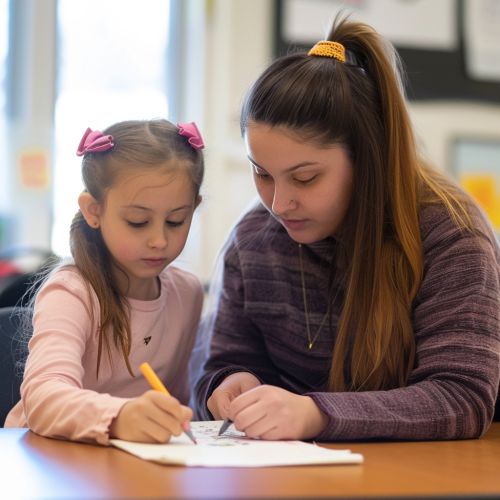Phonological Dysgraphia: Difference between revisions
No edit summary |
No edit summary |
||
| Line 58: | Line 58: | ||
Phonological dysgraphia is a complex learning disability that significantly impacts writing abilities due to difficulties with phonological processing. Understanding its characteristics, causes, and effective interventions is essential for providing appropriate support to individuals affected by this condition. Continued research and advancements in educational strategies and technology offer hope for improved outcomes for those with phonological dysgraphia. | Phonological dysgraphia is a complex learning disability that significantly impacts writing abilities due to difficulties with phonological processing. Understanding its characteristics, causes, and effective interventions is essential for providing appropriate support to individuals affected by this condition. Continued research and advancements in educational strategies and technology offer hope for improved outcomes for those with phonological dysgraphia. | ||
[[Image:Detail-79549.jpg|thumb|center|A student working with a teacher on a writing exercise, focusing on phonological awareness tasks.]] | [[Image:Detail-79549.jpg|thumb|center|A student working with a teacher on a writing exercise, focusing on phonological awareness tasks.|class=only_on_mobile]] | ||
[[Image:Detail-79550.jpg|thumb|center|A student working with a teacher on a writing exercise, focusing on phonological awareness tasks.|class=only_on_desktop]] | |||
== See Also == | == See Also == | ||
Latest revision as of 21:08, 18 May 2024
Introduction
Phonological dysgraphia is a specific type of dysgraphia, a learning disability that affects writing abilities. It is characterized by difficulties in spelling and writing that stem from problems with phonological processing, the ability to understand and manipulate the sounds of language. Individuals with phonological dysgraphia often struggle to spell non-words or unfamiliar words, as they cannot rely on their phonological skills to sound out the words.
Characteristics
Phonological dysgraphia primarily affects the ability to convert phonemes (the smallest units of sound in speech) into graphemes (the smallest units of written language). This condition is distinct from other forms of dysgraphia, such as surface dysgraphia, which involves difficulties with the visual recognition of words.
People with phonological dysgraphia may exhibit the following characteristics:
- Difficulty spelling unfamiliar or non-words.
- Reliance on visual memory for spelling familiar words.
- Frequent phonetic spelling errors.
- Problems with phonological awareness tasks, such as rhyming or segmenting words into individual sounds.
Causes
The exact causes of phonological dysgraphia are not fully understood, but it is believed to result from neurological differences that affect phonological processing. Research suggests that these differences may be linked to abnormalities in the left hemisphere of the brain, particularly in areas associated with language processing, such as the Broca's area and the Wernicke's area.
Genetic factors may also play a role, as dysgraphia often runs in families. Environmental factors, such as early language exposure and educational opportunities, can influence the severity of the condition.
Diagnosis
Diagnosing phonological dysgraphia typically involves a comprehensive assessment by a multidisciplinary team, including psychologists, speech-language pathologists, and educators. The assessment may include:
- Standardized tests of spelling and writing.
- Phonological awareness tasks.
- Analysis of writing samples.
- Cognitive and language assessments.
Early diagnosis is crucial for effective intervention and support.
Intervention and Treatment
Interventions for phonological dysgraphia focus on improving phonological processing skills and providing strategies to compensate for difficulties. Common approaches include:
- **Phonological Awareness Training**: Exercises to improve the ability to recognize and manipulate sounds in words.
- **Multisensory Instruction**: Teaching methods that engage multiple senses, such as visual, auditory, and kinesthetic, to reinforce learning.
- **Assistive Technology**: Tools such as speech-to-text software and spell-checkers to aid writing.
- **Explicit Spelling Instruction**: Systematic teaching of spelling rules and patterns.
Educational Strategies
Educators can support students with phonological dysgraphia by implementing specific strategies in the classroom:
- Providing extra time for writing tasks.
- Allowing the use of assistive technology.
- Offering alternative assessments, such as oral presentations.
- Breaking writing tasks into smaller, manageable steps.
- Using graphic organizers to help plan and organize writing.
Neurobiological Perspectives
Neuroimaging studies have provided insights into the brain mechanisms underlying phonological dysgraphia. Functional MRI (fMRI) and other imaging techniques have revealed reduced activation in the left hemisphere language areas during phonological tasks. These findings suggest that phonological dysgraphia may be associated with atypical neural connectivity and processing in regions critical for phonological processing.
Research and Future Directions
Ongoing research aims to further understand the neural and genetic basis of phonological dysgraphia. Advances in neuroimaging and genetic analysis hold promise for identifying biomarkers that could lead to earlier diagnosis and more targeted interventions. Additionally, studies on the effectiveness of various intervention strategies continue to inform best practices for supporting individuals with phonological dysgraphia.
Conclusion
Phonological dysgraphia is a complex learning disability that significantly impacts writing abilities due to difficulties with phonological processing. Understanding its characteristics, causes, and effective interventions is essential for providing appropriate support to individuals affected by this condition. Continued research and advancements in educational strategies and technology offer hope for improved outcomes for those with phonological dysgraphia.


